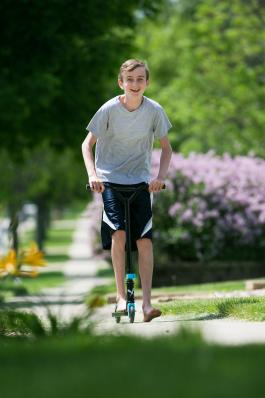Joshua Osborn’s brain had been swelling for weeks, but his doctors didn’t know why. The problem began with headaches in April 2013. By August, the 14-year-old Wisconsin boy had been through a barrage of tests, including a spinal tap and a brain biopsy. He was in a medically induced coma and the months-long investigation had turned up no suspects.
Such fruitless efforts to identify a pathogen aren’t uncommon. Even if an infectious agent is found, it’s often after days or weeks of tests and tissue cultures. Josh didn’t have that kind of time.
The doctor working on Josh’s case contacted renowned UCSF molecular biologist Joe DeRisi, PhD, who was eager to help. Samples of Josh’s blood and cerebral spinal fluid made their way to pathologist Charles Chiu, MD, PhD and director of UCSF-Abbott Viral Diagnostics and Discovery Center. Chiu, who started as a postdoctoral fellow in DeRisi's lab, had developed a new approach to solving mysteries such as this one. It involves two steps: using a superfast technique for reading out DNA sequences and then analyzing them for matches with disease-causing pathogens of all kinds.
The technique exemplifies the new victories that can be achieved as ‘omic technologies mature beyond the lab and enter the clinic.
Chiu’s lab performed NGS on Josh’s samples to detect the presence of anything in it that wasn’t human. The sequencing was completed overnight.
Next, Chiu’s team employed pathogen-sleuthing software developed in their lab. The program, named SURPI, rapidly matches sample DNA with the DNA of organisms in ever-expanding national genome databases.
They discovered that some of the 3 million DNA sequences from Josh’s cerebral spinal fluid matched sequences for a bacterium called Leptospira. Just a few years ago, this type of data-heavy analysis would have taken days or even weeks. Josh’s results came back in just 96 minutes.

That’s not unusual. For example, according to Chiu, only about half of meningitis patients are fully diagnosed.
Chiu’s approach to finding the DNA needle in the haystack holds great promise for solving such mysteries. One of the most powerful aspects of his novel sequencing scheme is that it can detect all pathogens – viruses, bacteria, fungi and parasites – with a single test.
A panel working with the California Initiative to Advance Precision Medicine agrees. In August 2015, the panel selected Chiu’s technology for funding as a demonstration project. His team will use the new approach to diagnose meningitis, encephalitis, pneumonia and sepsis in 300 critically ill hospitalized patients. The study will take place across three UC medical centers over 18 months, and will be the first-ever demonstration of precision medicine in infectious diseases. This project will also be a key part of the UCSF Center for Next-Gen Precision Medicine Diagnostics, headed by DeRisi and established last month with the support of the Sandler and William K Bowes, Jr. Foundations.
Chiu’s team, which includes partners within the UC system as well as industry, hopes to make the test available to hospitals around the state soon.
“We need these tools now to make a difference for our sickest patients,” Chiu says.
A successful demonstration will have impact far beyond UC. The NGS-based approach could prove vital in identifying cases of respiratory and blood-borne illnesses, tick-borne disease and even outbreaks of new or rare diseases. That could help practitioners stem a tide of infection before it starts.
